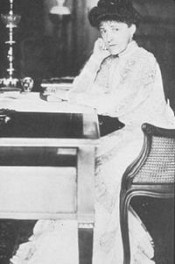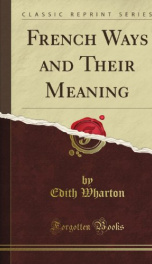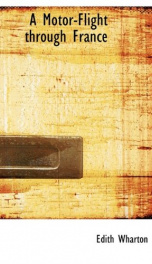Wharton Edith

Edith Wharton (January 24, 1862 – August 11, 1937) was an American novelist, short story writer and designer.[1] Wharton was born Edith Newbold Jones to parents George Frederic Jones and Lucretia Stevens Rhinelander. She had two brothers, Frederic Rhinelander and Henry Edward. The saying "Keeping up with the Joneses" is said to refer to the family of her father.[2] She combined her insider's view of America's privileged classes with a brilliant, natural wit to write humorous and incisive novels and short stories. As such, she was well-acquainted with many of her era's literary and public figures, including Henry James and Theodore Roosevelt. In 1885, at 23 years of age, she married Edward (Teddy) Robbins Wharton, who was twelve years her senior. From a well-established Boston family, he was a sportsman and a gentleman of her social class and shared her love of travel, although they had little in common intellectually. He began spending money on younger women and this began to take a toll on Wharton's mental health. They divorced in 1913, after she suffered a nervous breakdown and was confined to a hospital. She then moved to Europe. Edith and Edward were married for 28 years, though she later called the marriage her "greatest mistake." In addition to her famous novels, Wharton wrote at least 85 short stories, and was also a highly regarded landscape architect, interior designer, and taste-maker of her time. She wrote several influential books including her first published work,The Decoration of Houses, co-authored by Ogden Codman, and Italian Villas and Their Gardens.[3] In 1902 she built The Mount, her estate in Lenox, Massachusetts, which survives today as the supreme example of her design principles. The house and its gardens have been extensively restored and are open to the public from May through October although, as of the end of March 2008, the house museum is threatened with foreclosure.[4] There, Edith Wharton wrote several of her novels, including The House of Mirth (1905), the first of many chronicles of the true nature of old New York, and entertained the cream of American literary society, including her close friend, the novelist Henry James. Although she spent many months traveling in Europe nearly every year, The Mount was her primary residence until 1911. When she was there, as well as traveling abroad, Wharton was usually driven to her appointments by her longtime chauffeur and friend Charles Cook, a native of nearby South Lee, Massachusetts.[5][6] When her marriage deteriorated, however, she decided to move permanently to France, living initially at 58 Rue de Varenne, Paris, in an apartment that belonged to George Washington Vanderbilt II. Helped by her influential connections to the French government, primarily Walter Berry (then president of the American Chamber of Commerce in Paris), she was one of the few foreigners in France who was allowed travel to the front lines. Wharton described those trips in the series of articles Fighting France: From Dunkerque to Belfort. Throughout the war she worked tirelessly in charitable efforts for refugees, and, in 1916, was named a Chevalier of the Legion of Honor in recognition of her commitment to the displaced. The scope of her relief work included setting up work rooms for unemployed Frenchwomen, organizing concerts to provide work for musicians, opening tuberculosis hospitals, and founding the American Hostels for Belgian refugees. In 1916, Wharton edited The Book of the Homeless, composed of writings, art, erotica, and musical scores by almost every major contemporary European artist. When World War I ended in 1918 she abandoned the fashionable urban address for the delights of the country at the Pavillon Colombe in nearby Saint-Brice-sous-Forêt. Wharton was a committed supporter of French imperialism, describing herself as a "rabid imperialist".[7] After World War I, she travelled to Morocco as the guest of the Resident General, General Hubert Lyautey, and wrote a book In Morocco, about her experiences. Wharton's writing on her Moroccan travels is full of praise for the French administration and for Lyautey and his wife in particular. After the war she divided her time between Paris and Hyères, in Provence, where she finished The Age of Innocence in 1920. In 1927 she purchased a villa, Castel Sainte-Claire, on the site of a seventeenth-century convent, in the hills above the city of Hyères in Provence, where she lived during the winters and springs. She called the villa "Sainte-Claire du Chateau" and filled the garden with cactus and subtropical plants. She returned to the U.S. only once after the war, to receive an honorary doctorate degree from Yale University in 1923. The Age of Innocence (1920) won the 1921 Pulitzer Prize for literature,[8] making her the first woman to win the award. She spoke flawless French as well as several other languages and many of her books were published in both French and English. Wharton was friend and confidante to many gifted intellectuals of her time: Henry James, Sinclair Lewis, Jean Cocteau, and André Gide were all guests of hers at one time or another. Bernard Berenson and Kenneth Clark were valued friends as well, and she was the godmother of Clark's second son, Colin (1932–2002), who wrote the book The Prince, the Showgirl and Me about his work as third assistant director of the film The Prince and the Showgirl. Her meeting with F. Scott Fitzgerald is described by the editors of her letters as "one of the better-known failed encounters in the American literary annals". She was also good friends with Theodore Roosevelt. In 1934 Wharton's autobiography A Backward Glance was published. In the view of Judith E. Funston, in the entry she wrote for American National Biography about Wharton, "What is most notable about A Backward Glance, however, is what it does not tell: her criticism of Lucretia Jones [her mother], her difficulties with Teddy, and her affair with Morton Fullerton, which did not come to light until her papers, deposited in Yale’s Beinecke Rare Book Room and Manuscript Library, were opened in 1968."[9] She died in 1937 at the domaine Le Pavillon Colombe, her eighteenth-century house on Rue de Montmorency in Saint-Brice-sous-Forêt, in the then existing département of Seine-et-Oise (78), but now in Val d'Oise (95). The street is today called Rue Edith Wharton. [1][10] She is buried in the American Cemetery in Versailles, France. Wharton continued writing until her death, lying in bed and dropping each finished page to the floor to be collected when she finished. Wharton's last novel, The Buccaneers, was unfinished at the time of her death. Marion Mainwaring finished the story after carefully studying the notes and synopsis Wharton had previously written. The novel was published in 1938 (unfinished version) and 1993 (Mainwaring's completion). Many of Wharton's novels are characterized by a subtle use of dramatic irony. Having grown up in upper-class pre-World War I society, Wharton became one of its most astute critics. In such works as The House of Mirth and The Age of Innocence she employed both humor and profound empathy to describe the lives of New York's upper-class and the vanishing of their world in the early years of the 20th century. In contrast, she used a harsher tone in her novel Ethan Frome to convey the atmosphere of lower-class rural Massachusetts. In addition to writing several respected novels, Wharton produced a wealth of short stories and is particularly well regarded for her ghost stories. In The Young Indiana Jones Chronicles, Edith Wharton (Clare Higgins) travels across North Africa with Indiana Jones in Chapter 16, Tales of Innocence. Edith Wharton is mentioned in the HBO television series "Entourage" in the third season's thirteenth episode: Vince is handed a screenplay for Wharton's The Glimpses of the Moon by Amanda, his new agent, for a film to be directed by Sam Mendes. In the same episode, period films of Wharton's work are lampooned by agent Ari Gold, who says that all her stories are "about a guy who likes a girl, but he can't have sex with her for five years, because those were the times!" Carla Gugino, who plays Amanda, was the protagonist of the BBC-PBS adaptation of The Buccaneers (1995), one of her early jobs. A musical version of The Glimpses of the Moon was presented in New York City in the Algonquin Hotel's Oak Room in early 2008. Suzanne Vega's seventh studio release Beauty & Crime contains a song named "Edith Wharton's Figurines." "Edith Wharton's Journey" is a radio adaptation, for the NPR series Radio Tales, of the short story "A Journey" from Edith Wharton's collection The Greater Inclination. In 2009, Edith Wharton's home, The Mount, was investigated for paranormal activity in the hit Sci Fi Channel reality series Ghost Hunters. In an episode of the CW show Gossip Girl, "The Age of Dissonance", the cast star in a production of Wharton's "The Age of Innocence". The Beinecke Library at Yale University houses the Edith Wharton Collection. The collection contains some 50,000 items, consisting of letters, manuscripts, photographs, and miscellaneous personal items belonging to Edith Wharton. Currently a portion of this collection is available online.[11]
do you like this author?
What readers are saying
What do you think? Write your own comment on this book!
write a commentWhat readers are saying
What do you think? Write your own comment on this author!
write a commentBook list

italian backgrounds
Series:
Unknown
Year:
Unknown
Raiting:
2.5/5
A non-fiction by Edith Wharton, a Pulitzer Prize-winning American novelist, short story writer and designer. Published in 1905, this travel writing offers a detailed descriptions of the ancient country, its landscapes, culture, people, paintings, murals, frescoes and sculpture. The book also contrasts European classic examples of buildings with American architectural innovations. Wharton expressed her distrust to impetuous striving of the Americans to introduce new technical improvements to the development of house-building architecture in the beginning of the twentieth century, complaining about the featureless modernity.
Show more
add to favoritesadd In favorites

french ways and their meaning
Series:
Unknown
Year:
Unknown
Raiting:
3/5
Edith Wharton was a very perceptive writer and a great novelist. Her observations on the French in most cases are right on target. However, people going to France for work or pleasure need to understand that she is writing about France in the early part of the 20th century before and during World War I. When a person writes about a culture there observations only refer to that particular time and that particular place. Another thing to remember is that she also writes about upper-class French life. This is a very entertaining and insightful book on the French.
Show more
add to favoritesadd In favorites

a motor flight through france
Series:
Unknown
Year:
Unknown
Raiting:
2.5/5
One of the non-fiction works of a one of the most celebrated female authors of the early 20th century, famous for naturalistic novels that depicted New York high society, Edith Wharton. A travel book “A Motor-Flight through France”, published in 1908, describes three of Wharton's journeys in a chauffeur-driven Panhard with servants and luggage, the first part taking the reader from northern France to southern France and back. The author offers an account of the French countryside, most memorable visits, various places, a number of churches and other buildings of historic interest.
Show more
add to favoritesadd In favorites

a gift from the grave
Series:
Unknown
Year:
Unknown
Raiting:
4.5/5
» was again pronounced against him by PasquallL, who had succeeded Urban on the pontifical throne. Henry declared war against Robert of Flanders, on account of his adherence to the papal party, which had the majority of the nation on its side, but was at length driven to seek a reconciliation with the pope, whose favor he attempted to propitiate, by setting on foot another crusade, which, however, did not take place.About the Publisher Forgotten Books is a publisher of historical writings, such as: Philosophy, Classics, Science, Religion, History, Folklore and Mythology.Forgotten Books' Classic Reprint Series utilizes the latest technology to regenerate facsimiles of historically important writings. Careful attention has been made to accurately preserve the original format of each page whilst digitally enhancing the difficult to read text. Read books online for free at www.forgottenbooks.org
Show more
add to favoritesadd In favorites

The Triumph Of Night
Series:
Unknown
Year:
Unknown
Raiting:
4/5
Edith Wharton (1862-1937), born Edith Newbold Jones, was an American novelist, short story writer, and designer. She combined her insider's view of America's privileged classes with a brilliant, natural wit to write humourous and incisive novels and short stories. Wharton was well-acquainted with many of her era's literary and public figures, including Henry James and Theodore Roosevelt. Besides her writing, she was a highly regarded landscape architect, interior designer, and taste-maker of her time. She wrote several influential books, including The Decoration of Houses (1897), her first published work, and Italian Villas and Their Gardens (1904). The Age of Innocence (1920), perhaps her best known work, won the 1921 Pulitzer Prize for literature, making her the first woman to win the award. Her other works include: The Greater Inclination (1899), The Touchstone (1900), Sanctuary (1903), The Descent of Man and Other Stories (1904), The House of Mirth (1905), Madame de Treymes (1907), The Fruit of the Tree (1907), The Hermit and the Wild Woman and Other Stories (1908), Ethan Frome (1912), In Morocco (1921), and The Glimpses of the Moon (1921). --This text refers to an alternate Paperback edition.
Show more
add to favoritesadd In favorites
What readers are saying
What do you think? Write your own comment on this author!
write a commentif you like Wharton Edith try:
readers also enjoyed
What readers are saying
What do you think? Write your own comment on this author!
write a commentGenre
if you like Wharton Edith try:
readers also enjoyed
Do you want to exchange books? It’s EASY!
Get registered and find other users who want to give their favourite books to good hands!


